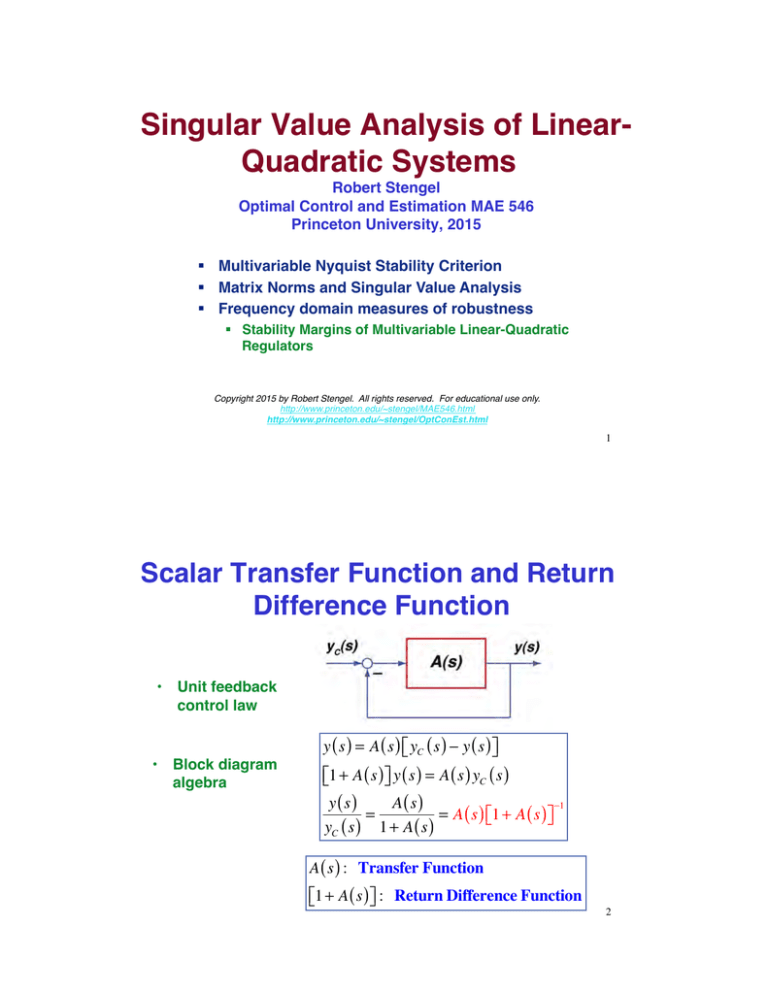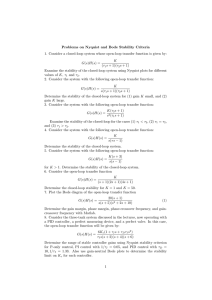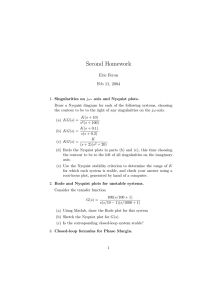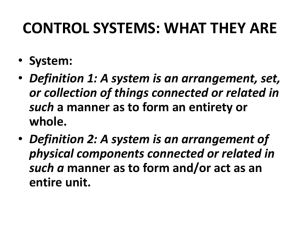
Singular Value Analysis of LinearQuadratic Systems !
Robert Stengel!
Optimal Control and Estimation MAE 546 !
Princeton University, 2015"
!! Multivariable Nyquist Stability Criterion"
!! Matrix Norms and Singular Value Analysis"
!! Frequency domain measures of robustness"
!! Stability Margins of Multivariable Linear-Quadratic
Regulators"
Copyright 2015 by Robert Stengel. All rights reserved. For educational use only.!
http://www.princeton.edu/~stengel/MAE546.html!
http://www.princeton.edu/~stengel/OptConEst.html
!
1!
Scalar Transfer Function and Return
Difference Function"
•! Unit feedback
control law"
•! Block diagram
algebra"
y ( s ) = A ( s ) "# yC ( s ) ! y ( s ) $%
"#1 + A ( s ) $% y ( s ) = A ( s ) yC ( s )
y(s)
A(s)
!1
=
= A ( s ) "#1 + A ( s ) $%
yC ( s ) 1 + A ( s )
A ( s ) : Transfer Function
!"1 + A ( s ) #$ : Return Difference Function
2!
A(s) =
Relationship
Between SISO
Open- and ClosedLoop Characteristic
kn ( s )
Polynomials"
! OL ( s )
y(s)
kn ( s ) ! OL ( s )
kn ( s )
=
=
yC ( s ) "#1+ kn ( s ) ! OL ( s ) $% ! OL ( s ) "#1+ kn ( s ) ! OL ( s ) $%
kn ( s )
kn ( s )
=
=
! CL ( s )
"# ! OL ( s ) + kn ( s ) $%
!! Closed-loop polynomial
is open-loop polynomial
multiplied by return
difference function "
! CL ( s ) = ! OL ( s ) "#1 + A ( s ) $%
3!
Return Difference Function Matrix
for the Multivariable LQ Regulator"
Open-loop system"
s!x(s) = F!x(s) + G!u(s)
( sI " F ) !x(s) = G!u(s)
"1
!x(s) = ( sI " F ) G!u(s)
Linear-quadratic feedback control law"
!u ( s ) = "R "1GT P!x ( s ) ! "C!x ( s )
= "C ( sI " F ) G!u(s) ! "A ( s ) !u(s)
"1
4!
Multivariable LQ Regulator Portrayed
as a Unit-Feedback System"
5!
Broken-Loop Analysis of Unit-Feedback
Representation of LQ Regulator"
Cut the loop as shown"
Analyze signal flow from ! ( s ) to ! ( s )
! (s) = #$ uC (s) " A ( s ) ! (s) %&
#$ I m + A ( s ) %& ! (s) = uC (s)
! (s) = #$ I m + A ( s ) %& uC (s)
"1
!u(s) = A ( s ) " (s) = A ( s ) #$ I m + A ( s ) %& uC (s)
!1
Analogy to SISO closed-loop transfer function"
6!
Broken-Loop Analysis of Unit-Feedback
Representation of LQ Regulator"
Cut the loop as shown"
Analyze signal flow from ! u ( s ) to ! u ( s )
A ( s ) = C ( sI n ! F ) G
!1
!u(s) = A ( s ) " (s) = A ( s )[ uC (s) + u(s)]
! "# I m + A ( s ) $% u(s) = A ( s ) uC (s)
!u(s) = "# I m + A ( s ) $% A ( s ) uC (s)
!1
7!
Closed-Loop Transfer Function
Matrix is Commutative"
!u(s) = A ( s ) "# I m + A ( s ) $% uC (s)
!u(s) = "# I m + A ( s ) $% A ( s ) uC (s)
!1
!1
2nd-order example"
A[I + A] = [I + A] A
!1
" a1
$
$# a3
a2 % " a1 + 1
a2
'$
a4 ' $ a3
a4 + 1
&#
" (a a ! a a + a )
1 4
2 3
1
=$
$
a3
#
!1
!1
%
" a1 + 1
a2
' =$
a4 + 1
'&
$# a3
1
( a1a4 ! a2 a3 + a4 )
%
'
'&
!1
" a1
$
$# a3
a2 %
'
a4 '
&
%
' det ( I 2 + A )
'
&
8!
Relationship Between Multi-Input/MultiOutput (MIMO) Open- and Closed-Loop
Characteristic Polynomials"
I m + A ( s ) = I m + C ( sI n ! F ) G
!1
= Im +
! OL ( s ) I m +
CAdj ( sI n ! F ) G
" OL ( s )
CAdj ( sI n " F ) G
= ! OL ( s ) I m + A ( s ) = ! CL ( s ) = 0
! OL ( s )
Closed-loop polynomial is open-loop polynomial multiplied by
determinant of return difference function matrix"
9!
Multivariable Nyquist
Stability Criterion!
10!
Ratio of Closed- to Open-Loop
Characteristic Polynomials Tested in
Nyquist Stability Criterion"
Scalar Control"
" CAdj ( sI n & F ) G $
! CL ( s )
= "#1+ A ( s ) $% = '1+
(
! OL ( s )
! OL ( s )
#
%
= a ( s ) + jb ( s ) Scalar
Multivariate Control"
CAdj ( sI n " F ) G
! CL ( s )
= Im + A ( s ) = Im +
! OL ( s )
! OL ( s )
= a ( s ) + jb ( s ) Scalar
11!
Multivariable Nyquist
Stability Criterion"
! CL ( s )
= I m + A ( s ) ! a ( s ) + jb ( s ) Scalar
! OL ( s )
Same stability criteria for encirclements of –1 point apply for
scalar and vector control"
Eigenvalue Plot, “D Contour”!
Nyquist Plot"
Nyquist Plot, shifted origin"
12!
Limits of Multivariable
Nyquist Stability Criterion"
! CL ( s )
= I m + A ( s ) ! a ( s ) + jb ( s ) Scalar
! OL ( s )
•! Multivariable Nyquist Stability Criterion "
–! Indicates stability of the nominal system"
–! In the |I + A(s)| plane, Nyquist plot depicts
the ratio of closed-to-open-loop
characteristic polynomials"
•! However, determinant is not a good
indicator for the size of a matrix"
–! Little can be said about robustness"
–! Therefore, analogies to gain and phase margins
are not readily identified"
13!
Determinant is Not a Reliable
Measure of Matrix Size
"
! 1 0 $
A1 = #
&;
0
2
"
%
! 1 100 $
A2 = #
&;
0
2
"
%
A1 = 2
A2 = 2
! 1 100 $
A3 = #
&;
0.02
2
"
%
A3 = 0
•! Qualitatively,"
–! A1 and A2 have the same determinant"
–! A2 and A3 are about the same size"
14!
Matrix Norms and
Singular Value Analysis!
15!
Vector Norms"
Euclidean norm"
( )
x = xT x
1/2
Weighted Euclidean norm"
(
Dx = xT DT Dx
)
1/2
For fixed value of ||x||,"
||Dx|| provides a measure of the size of D"
16!
Spectral Norm (or Matrix Norm)"
Spectral norm has more than one size"
D = max Dx is real-valued
x =1
dim ( x ) = dim ( Dx ) = n ! 1; dim ( D ) = n ! n
Also called Induced Euclidean norm"
If D and x are complex"
(
x = xH x
(
)
1/2
Dx = x H D H Dx
where
)
1/2
x H ! complex conjugate transpose of x
= Hermitian transpose of x
17!
Spectral Norm (or Matrix Norm)"
Spectral norm of D"
D = max Dx
x =1
DTD or DHD has n eigenvalues"
Eigenvalues are all real, as DTD is symmetric and DHD is
Hermitian"
Square roots of eigenvalues are called singular values"
18!
Singular Values of D"
Singular values of D"
! i ( D ) = "i ( DT D ) , i = 1, n
Maximum singular value of D"
! max ( D ) ! ! ( D ) ! D = max Dx
x =1
Minimum singular value of D"
! min ( D ) ! ! ( D ) = 1 D "1 = min Dx
x =1
19!
Comparison of
Determinants and
Singular Values"
! 1 0 $
A1 = #
&;
" 0 2 %
! 1 100 $
A2 = #
&;
" 0 2 %
A1 = 2
A2 = 2
! 1 100 $
A3 = #
&;
" 0.02 2 %
A3 = 0
•!
•!
•!
Singular values provide a better
portrayal of matrix size, but ..."
Size
is multi-dimensional"
Singular values describe
magnitude along axes of a multidimensional ellipsoid" e.g.,
A1 : ! ( A1 ) = 2; ! ( A1 ) = 1
x 2 y2
+
=1
!2 !2
A 2 : ! ( A 2 ) = 100.025; ! ( A 2 ) = 0.02
A 3 : ! ( A 3 ) = 100.025; ! ( A 3 ) = 0
20!
Stability Margins of
Multivariable LQ Regulators!
21!
Bode Gain Criterion and the
Closed-Loop Transfer Function"
!! Bode magnitude criterion for
scalar open-loop transfer function"
!! High gain at low input frequency"
!! Low gain at high input frequency"
!! Behavior of unit-gain closed-loop
transfer function with high and low
open-loop amplitude ratio "
A ( j! )
y ( j! )
=
yC ( j! ) 1+ A ( j! )
A ( j! )
####
" A ( j! )
A( j! ) "0
####
"1
A( j! ) "$
22!
Additive Variations
in A(s)"
A o ( s ) = C o ( sI n ! Fo ) G o
!1
A ( s ) = A o ( s ) + !A ( s )
Connections to LQ open-loop transfer matrix"
Gain Change"
!A C ( s ) = !C ( sI n " Fo ) G o
Control Effect Change"
!A G ( s ) = C o ( sI n " Fo ) !G
{
"1
"1
Stability Matrix Change"
!A F ( s ) = C o #$ sI n " ( Fo + !F ) %& " #$ sI n " ( Fo ) %&
"1
"1
}G
o
23!
Conservative
Bounds for Additive
Variations in A(s)"
Assume original system is stable"
A o ( s ) !" I m + A o ( s ) #$
%1
Worst-case additive variation does not de-stabilize if"
! $% "A ( j# ) &' < ! $% I m + A o ( j# ) &' , 0 < # < (
Sandell, 1979!
24!
Bode Plot of Singular Values"
Singular values have magnitude but not phase"
! #$ I m + A o ( j" ) %&
20 log !
! $% "A ( j# ) &'
log !
Stability guaranteed for changing ! $% "A ( j# ) &'
up to the point that it touches ! $% I m + A o ( j# ) &'
25!
Multiplicative
Variations in A(s)"
A o ( s ) = C o ( sI n ! Fo ) G o
!1
A ( s ) = L PRE ( s ) A o ( s ) or A ( s ) = A o ( s ) L POST ( s )
•! Very complex relationship to system equations; suppose"
! l (s) 0 0 $
# 11
&
L ( s ) = I3 + # 0
0 0 & = I 3 + 'L ( s )
# 0
0 0 &%
"
!L ( s ) affects first row of A o ( s ) for pre-multiplication
!L ( s ) affects first column of A o ( s ) for post-multiplication
Sandell, 1979!
26!
Bounds on Multiplicative
Variations in A(s)"
A o ( s ) = C o ( sI n ! Fo ) G o
!1
! $% "L ( j# ) &' < ! $% I m + A (1
o ( j# ) &
', 0 < # < )
! $% I m + A "1
o ( j# ) &
'
20 log !
! $% "L ( j# ) &'
log !
27!
Desirable Bode Gain Criterion
Attributes"
At low frequency"
! #$ I m + A ( j" ) %& > ! min (" ) > 1
{
! $% I m + A "1 ( j# ) &'
At high frequency"
"1
}
=
1
< ! max (# )
! $% I m + A "1 ( j# ) &'
28!
Desirable Bode Gain
Criterion
Attributes"
! #$ A ( j" ) %&
Undesirable
Region"
Undesirable
Region"
! #$ A ( j" ) %&
! C1
! C2
Crossover Frequencies"
log !
29!
Next Time:!
Probability and Statistics!
30!
Supplemental Material
31!
Sensitivity and Complementary
Sensitivity Matrices of A(s)"
Sensitivity matrix"
S ( s ) ! !" I m + A ( s ) #$
%1
Inverse return difference matrix"
"# I m + A !1 ( s ) $%
Complementary sensitivity matrix"
T ( s ) ! A ( s ) !" I m + A ( s ) #$
%1
32!
Sensitivity and Complementary
Sensitivity Matrices of A(s)"
Small S ( j! ) implies low sensitivity to parameter variations as a function of frequency
S ( j! ) ! "# I m + A ( j! ) $%
&1
Small T ( j! ) implies low noise response as a function of frequency
T ( j! ) ! A ( j! ) "# I m + A ( j! ) $%
&1
33!
Sensitivity and Complementary
Sensitivity Matrices of A(s)"
•! But"
S ( j! ) + T ( j! ) ! "# I m + A ( j! ) $% + A ( j! ) "# I m + A ( j! ) $%
&1
&1
= "# I m + A ( j! ) $% "# I m + A ( j! ) $% = I m
&1
•! Therefore, there is a
tradeoff between
robustness and
noise suppression"
S ( j! )
T ( j! )
log !
34!
Alternative Criteria for
Multiplicative Variations in A(s)"
•! Definitions"
! OL ( s ) : Open-loop characteristic polynomial of original system
!! OL ( s ) : Perturbed characteristic polynomial of original system
! CL ( s ) : Stable closed-loop characteristic polynomial of original system
{!!
OL
( j" ) = 0} implies that !OL ( j" ) = 0
for any " on # R (i.e., vertical component of "D contour")
$ = % &' I m + A o ( j" ) () for any " on # R
Lehtomaki, Sandell, Athans, 1981!
35!
Alternative Criteria
for Multiplicative
Variations in A(s)"
•! Perturbed closed-loop system is stable if"
! $% L"1 ( j# ) " I m &' < ( = ! $% I m + A o ( j# ) &'
And at least one of the following is satisfied:
• ( <1
• LH ( j# ) + L ( j# ) ) 0
(
)
• 4 ( 2 " 1 ! 2 $% L ( j# ) " I m &' > ( 2! 2 $% L ( j# ) + LH ( j# ) " 2I m &'
36!
Guaranteed Gain and
Phase Margins"
If
! #$ I m + A o ( j" ) %& > ' o ( 1
•! Guaranteed Gain Margin"
K=
1
1 ± !o
In each of m
control loops"
•! Guaranteed Phase Margin"
$ # o2 '
! = ± cos & 1 " )
2 (
%
37!
Guaranteed Gain
and Phase Margins"
If
LH ( j! ) + L ( j! ) " 0
and
A oH ( j! ) + A o ( j! ) " 0
•! Guaranteed Gain Margin" •! Guaranteed Phase Margin"
K = ( 0, ! )
! = ±90°
In each of m
control loops"
38!
Control Design for Increased
Gain Margin"
!! Obtain lowest possible LQ control gain matrix, C, by
choosing large R"
!! Gain margin is 1/2 of these gains"
!! Speed of response (e.g., bandwidth) may be too slow"
!! Increase gains to restore desired bandwidth"
!! Control system is sub-optimal but has higher gain margin
than LQ system designed for same bandwidth"
39!
Control Design for Increased
Gain Margin"
!! High R, low-gain
optimal controller"
R ! !2Ro
FT P + PF + Q " PGR "1GT P = 0
C opt = R "1GT P
!! Increased gain to
restore bandwidth"
!! Increased gain margin for
high-bandwidth controller"
T
2
C sub ! opt = R !1
o G P = " C opt
$ 1
'
K sub ! opt = & 2 , # )
% 2"
(
40!
Example: Control Design
for Increased Robustness !
(Ray, Stengel, 1991)"
!! Open-loop longitudinal eigenvalues"
!1" 4 = "0.1 ± 0.057 j, " 5.15, 3.35
!! Three controllers"
!! a) Q = diag(1 1 1 0) and R = 1"
!! b) R = 1000"
!! c) Case (b) with gains multiplied by 5"
41!
Root Loci for Three Cases"
Transmission zeros"
z1,2 = "# 0 !1.2 $%
Case a!
Case b!
Case c!
!! Closed-loop system roots"
!! Originate at stable images of open-loop poles"
!! 2 roots to transmission zeros"
!! 2 roots to –#, multiple Butterworth spacing"
42!
Loop Transfer Function
Frequency Response with
Elevator Control"
H ( j! ) = C ( j! I " F ) G
"1
Q = !" 1 0 1 0 #$ , R = 1 or 1000
43!
Loop Transfer Function Nyquist Plots
with Elevator Control"
H ( j! ) = C ( j! I " F ) G
"1
44!
Loop Transfer Function Nichols
Charts with Elevator Control"
H ( j! ) = C ( j! I " F ) G
"1
45!
Probability of Instability Describes
Robustness to Parameter Uncertainty !
(Ray, Stengel, 1991)"
!!
Distribution of closed-loop roots with"
!!
!!
!!
Gaussian uncertainty in 10 parameters"
Uniform uncertainty in velocity and air density"
25,000 Monte Carlo evaluations"
Stochastic Root Locus!
!!
!!
!!
!!
Probability of instability"
a) Pr = 0.072"
b) Pr = 0.021"
c) Pr = 0.0076"
46!




